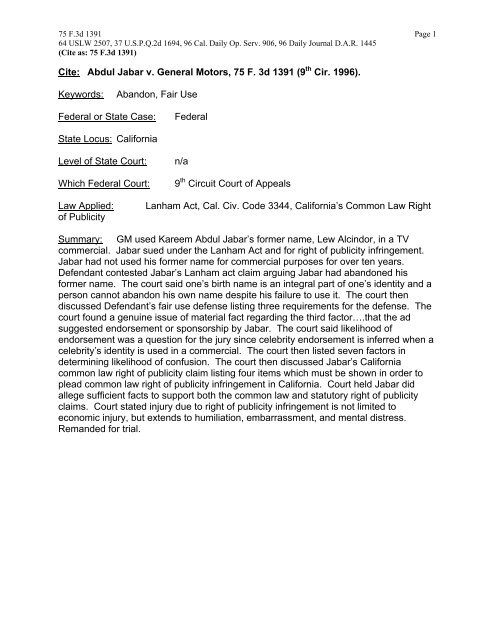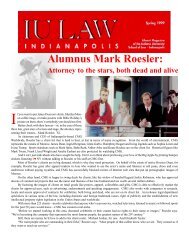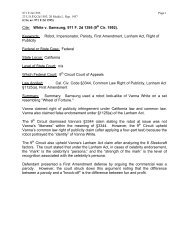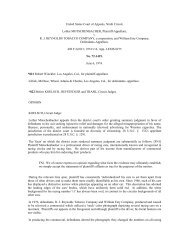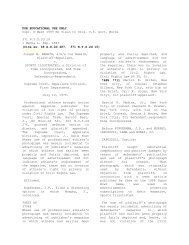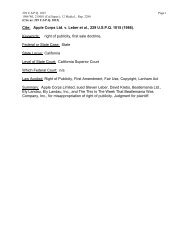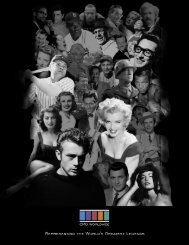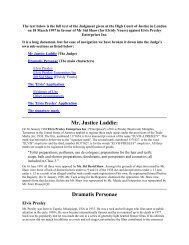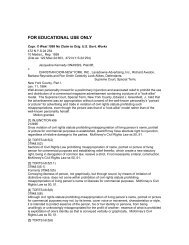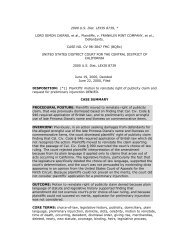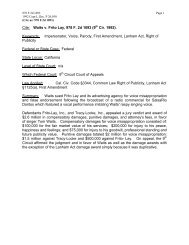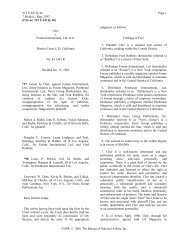Abdul Jabbar v. General Motors - Mark Roesler
Abdul Jabbar v. General Motors - Mark Roesler
Abdul Jabbar v. General Motors - Mark Roesler
- No tags were found...
You also want an ePaper? Increase the reach of your titles
YUMPU automatically turns print PDFs into web optimized ePapers that Google loves.
75 F.3d 1391 Page 464 USLW 2507, 37 U.S.P.Q.2d 1694, 96 Cal. Daily Op. Serv. 906, 96 Daily Journal D.A.R. 1445(Cite as: 75 F.3d 1391)GMC offers two defenses in response to thisclaim: 1) <strong>Abdul</strong>-<strong>Jabbar</strong> lost his rights to the nameLew Alcindor when he "abandoned" it; and 2)GMC's use of the name Lew Alcindor was anominative fair use which is not subject to theprotection of the Lanham Act. The district courtheld both defenses applicable.a) Abandonment under the Lanham ActWhile the district court found that there was nodispute as to GMC's failure to seek or obtain<strong>Abdul</strong>-<strong>Jabbar</strong>'s consent to use his former name inits commercial, and that "on its face, the LanhamAct applies," it held that GMC was entitled tosummary judgment on the basis of its finding that<strong>Abdul</strong>-<strong>Jabbar</strong> had abandoned his former namethrough nonuse under the Lanham Act. Title 15U.S.C. § 1127 (1992) provides in pertinent part:A mark shall be deemed to be "abandoned" wheneither of the following occurs:(1) When its use has been discontinued with intentnot to resume such use. Intent not to resume maybe inferred from circumstances. Nonuse for twoconsecutive years shall be prima facie evidence ofabandonment. "Use" of a mark means the bonafide use of that mark made in the ordinary courseof trade, and not merely to reserve a right in amark.(2) When any course of conduct of the owner,including acts of omission as well as commission,causes the mark to become ... generic....[4] Once created, a prima facie case ofabandonment may be rebutted by showing validreasons for nonuse or lack of intent to abandon themark. Star-Kist Foods, Inc. v. P.J. Rhodes & Co.,769 F.2d 1393, 1396 (9th Cir.1985). [FN4]Because <strong>Abdul</strong>-<strong>Jabbar</strong> acknowledged that he hadnot used the name Lew Alcindor in over ten years,and because the district court found that plaintiff'sproffered religious reasons for nonuse were notapplicable, [FN5] the court held that <strong>Abdul</strong>-<strong>Jabbar</strong>had in effect abandoned the name.FN4. In some circuits, a showing of nonuseshifts the burden of persuasion to thetrademark owner to show intent to resume;in others, including the Ninth, Second andSeventh, prima facie abandonment createsonly a rebuttable presumption ofabandonment.FN5. We need not decide whether <strong>Abdul</strong>-<strong>Jabbar</strong>'s proffered reasons for non-use of hisbirth name would serve to rebut a primafacie case of abandonment. <strong>Abdul</strong>-<strong>Jabbar</strong>argues that the district court's abandonmentruling substantially burdens his FirstAmendment right to free exercise ofreligion. The gist of this argument is thatby holding that one loses rights to his givenname on adopting a new name for religiouspurposes, the court puts pressure on areligious believer to "modify his behaviorand violate his beliefs." See Frazee v.Illinois Dep't of Employment Sec., 489 U.S.829, 832, 109 S.Ct. 1514, 1516, 103 L.Ed.2d914 (1989). Because we hold GMC failedto establish a prima facie case ofabandonment under the Lanham Act, we donot reach or resolve this argument.[5][6] Trademark law withdraws its protection froma mark that has become generic and deems itavailable for general use. Given that*1396 the primary cost of recognizing propertyrights in trademarks is the removal of words from(or perhaps non-entrance into) our language, ... theholder of a trademark will be denied protection if itis (or becomes) generic, i.e., if it does not relateexclusively to the trademark owner's product.New Kids on the Block v. News America Pub.,Inc., 971 F.2d 302, 306 (9th Cir.1992). Similarly,the law ceases to protect the owner of anabandoned mark. Rather than countenancing the"removal" or retirement of the abandoned markfrom commercial speech, trademark law allows itto be used by another. Accordingly, courts haveheld that an unused mark may not be held inabeyance by its original owner. See, e.g., LaSociete Anonyme des Parfums Le Galion v. JeanPatou, Inc., 495 F.2d 1265, 1272 (2d Cir.1974).[FN6]FN6. GMC's reliance on Major LeagueBaseball Properties, Inc. v. Sed Non OletDenarius, Ltd., 817 F.Supp. 1103(S.D.N.Y.1993), vacated pursuant tosettlement, 859 F.Supp. 80 (S.D.N.Y.1994),is inapposite. Aside from the fact that avacated case is poor authority, we observethat, unlike the case at bar, Major Leaguewas decided after full consideration of the
75 F.3d 1391 Page 564 USLW 2507, 37 U.S.P.Q.2d 1694, 96 Cal. Daily Op. Serv. 906, 96 Daily Journal D.A.R. 1445(Cite as: 75 F.3d 1391)evidence at a trial on the merits.[7] While the Lanham Act has been applied to casesalleging appropriation of a celebrity's identity, theabandonment defense has never to our knowledgebeen applied to a person's name or identity. Wedecline to stretch the federal law of trademark toencompass such a defense. One's birth name is anintegral part of one's identity; it is not bestowed forcommercial purposes, nor is it "kept alive" throughcommercial use. A proper name thus cannot bedeemed "abandoned" throughout its possessor's life,despite his failure to use it, or continue to use it,commercially.[8] In other words, an individual's given name,unlike a trademark, has a life and a significance quiteapart from the commercial realm. Use or nonuse ofthe name for commercial purposes does not dispelthat significance. An individual's decision to use aname other than the birth name--whether the decisionrests on religious, marital, or other personalconsiderations--does not therefore imply intent to setaside the birth name, or the identity associated withthat name.[9] While the issue of whether GMC's use of thename Lew Alcindor constituted an endorsement of itsproduct is far from clear, we hold that GMC cannotrely on abandonment as a defense to <strong>Abdul</strong>-<strong>Jabbar</strong>'sLanham Act claim.b) Lanham Act "fair use" doctrineThe district court cited the "fair use" defense, 15U.S.C. § 1115(b)(4), as an alternative ground fordismissal of plaintiff's Lanham Act claim. Wediscussed this defense in New Kids, where we heldthat the use by two newspapers of the "New Kids"name to conduct phone-in polls measuring thegroup's popularity was a nominative or nontrademark"fair use" of the name not subject toprotection under the Lanham Act. 971 F.2d at 306-09."[T]rademark law recognizes a defense where themark is used only 'to describe the goods or servicesof [a] party, or their geographic origin.' " Id. at 306;(quoting 15 U.S.C. § 1115(b)(4)). We cited theexample of a Volkswagen repair shop which used thename "Volkswagen" in the sign advertising itsbusiness. Volkswagenwerk Aktiengesellschaft v.Church, 411 F.2d 350, 352 (9th Cir.1969). There,we had recognized that it " 'would be difficult, if notimpossible, ... to avoid altogether the use of the word"Volkswagen" or its abbreviation "VW" ... [to]signify appellant's cars.' ... Therefore, his use of theVolkswagen trademark was not an infringing use."Id. at 307 (quoting VolkswagenwerkAktiengesellschaft v. Church, 411 F.2d 350, 352 (9thCir.1969)).We explained that "[c]ases like these are bestunderstood as involving a non- trademark use of amark--a use to which the infringement laws simplydo not apply." Id.[W]e may generalize a class of cases where the useof the trademark does not attempt to capitalize onconsumer confusion or to appropriate the cachet ofone product for a different one. Such nominativeuse of a mark--where the only word reasonably*1397 available to describe a particular thing ispressed into service--lies outside the strictures oftrademark law: Because it does not implicate thesource-identification function that is the purpose ofthe trademark, it does not constitute unfaircompetition; such use is fair because it does notimply sponsorship or endorsement by thetrademark holder.Id. at 307-08.New Kids was not the classic fair use case becausethe New Kids trademark was being used not todescribe the defendant's own product (newspapers),but to describe the plaintiff's product (rock band).Id. at 308. However, we held that in such cases, acommercial user is nevertheless entitled to thenominative fair use defense if it meets threerequirements:First, the product or service in question must beone not readily identifiable without use of thetrademark; second, only so much of the mark ormarks may be used as is reasonably necessary toidentify the product or service; and third, the usermust do nothing that would, in conjunction withthe mark, suggest sponsorship or endorsement bythe trademark holder.Id. (footnotes omitted). Because 1) the New Kidsrock band could not be referenced without using itsname; and 2) the newspapers used the name onlyto the extent necessary to identify them; and 3)nothing in the newspaper announcements impliedsponsorship or endorsement by the New Kids, weheld that the papers were entitled to the nominativefair use defense. Id. at 308-10.[10] The district court here found that GMC met
75 F.3d 1391 Page 664 USLW 2507, 37 U.S.P.Q.2d 1694, 96 Cal. Daily Op. Serv. 906, 96 Daily Journal D.A.R. 1445(Cite as: 75 F.3d 1391)the three New Kids requirements as a matter of law.We conclude, however, that there was a genuineissue of fact as to the third requirement, impliedendorsement or sponsorship. Like the newspapersin New Kids, <strong>General</strong> <strong>Motors</strong> could not refer toplaintiff without using his name, and it used nomore th an was necessary to refer to him.Also, analogously to the newspapers in New Kidsasking their readers which New Kid was the best,sexiest, etc., the defendant was selling something,newspapers or cars, different from the product theplaintiff was selling, and their products could notbe confused.[11] The distinction between this case and NewKids is that use of celebrity endorsements intelevision commercials is so well established bycommercial custom that a jury might find animplied endorsement in <strong>General</strong> <strong>Motors</strong>' use of thecelebrity's name in a commercial, which would notinhere in a newspaper poll. Newspapers andmagazines commonly use celebrities' names andphotographs without making endorsementcontracts, so the public does not infer anendorsement agreement from the use. Manypeople may assume that when a celebrity's name isused in a television commercial, the celebrityendorses the product advertised. Likelihood ofconfusion as to endorsement is therefore a questionfor the jury. White v. Samsung Elec. Am., Inc., 971F.2d 1395, 1400-01 (9th Cir.1992) (holding thatuse of a robot dressed and posed like Vanna Whitenext to a "Wheel of Fortune" set raised sufficientquestion of fact as to endorsement under theLanham Act to preclude summary judgment), cert.denied, 508 U.S. 951, 113 S.Ct. 2443, 124 L.Ed.2d660 (1993).By using Alcindor's record to make a claim for itscar--like the basketball star, the Olds 88 won an"award" three years in a row, and like the star, thecar is a "champ" and a "first round pick"--GMChas arguably attempted to "appropriate the cachetof one product for a different one," if not also to"capitalize on consumer confusion." New Kids at308. We therefore hold that there is a question offact as to whether GMC is entitled to a fair usedefense.c) <strong>Abdul</strong>-<strong>Jabbar</strong>'s Lanham Act claim[12] In considering celebrities' claims of violationunder the Lanham Act, we have considered thefollowing factors to determine whether a plaintiffhas raised a genuine issue of material fact as tolikelihood of confusion over endorsement: "(1)strength of the plaintiff's mark; (2) relatedness ofthe goods; (3) similarity of the marks; (4)evidence of actual confusion; (5) marketingchannels used; (6) likely degree of purchaser care;(7) defendant's intent in selecting the mark."White, 971 F.2d at 1400.*1398 The parties dispute the applicability of thefactors. GMC concedes that the fifth factor,marketing channels, favors <strong>Abdul</strong>-<strong>Jabbar</strong>, butcontests the rest. Because a jury could reasonablyconclude that most of the factors weigh inplaintiff's favor, we hold that the question ofwhether <strong>Abdul</strong>- <strong>Jabbar</strong>'s Lanham Act claim shouldsucceed is a question for the jury.IIState law claims: Common Law and StatutoryRights of Privacy[13] "California has long recognized a common lawright of privacy ... [which includes protectionagainst] appropriation, for the defendant's advantage,of the plaintiff's name or likeness." Eastwood v.Superior Court for Los Angeles County, 149Cal.App.3d 409, 198 Cal.Rptr. 342, 346 (1983)(citations omitted). The right to be protected againstsuch appropriations is also referred to as the "right ofpublicity." Id., 198 Cal.Rptr. at 347.The so-called right of publicity means in essencethat the reaction of the public to name and likeness,which may be fortuitous or which may be managedand planned, endows the name and likeness of theperson involved with commercially exploitableopportunities. The protection of name andlikeness from unwarranted intrusion or exploitationis the heart of the law of privacy.Lugosi v. Universal Pictures, 25 Cal.3d 813, 160Cal.Rptr. 323, 329, 603 P.2d 425, 431 (1979).[14] As set out in Eastwood, a common law causeof action for appropriation of name or likeness maybe pleaded by alleging "(1) the defendant's use ofplaintiff's identity; (2) the appropriation ofplaintiff's name or likeness to defendant'sadvantage, commercially or otherwise; (3) lack ofconsent; and (4) resulting injury." 198 Cal.Rptr. at347.[15] We recently clarified in White that "the 'nameor likeness' formulation referred to in Eastwoodoriginated not as an element of the right ofpublicity cause of action, but as a description of the
75 F.3d 1391 Page 764 USLW 2507, 37 U.S.P.Q.2d 1694, 96 Cal. Daily Op. Serv. 906, 96 Daily Journal D.A.R. 1445(Cite as: 75 F.3d 1391)types of cases in which the cause of action hadbeen recognized." 971 F.2d at 1397. Accordingly,we held that California's common law "right ofpublicity is not limited to the appropriation ofname or likeness." Id. at 1398. The key issue isappropriation of the plaintiff's identity.It is not important how the defendant hasappropriated the plaintiff's identity, but whether thedefendant has done so.... A rule which says thatthe right of publicity can be infringed only throughthe use of nine different methods of appropriatingidentity merely challenges the clever advertisingstrategist to come up with the tenth.Id. (internal citations omitted).California's common law cause of action iscomplemented legislatively by Civil Code section3344. As the Eastwood court explained, thestatute is best understood as "complementing,"rather than enacting, the common law cause ofaction, because the two are not identical. 198Cal.Rptr. at 346. Section 3344(a) provides inpertinent part:Any person who knowingly uses another's name,voice, signature, photograph, or likeness, in anymanner, on or in products, merchandise, or goods,or for purchases of advertising or selling, orsoliciting purchases of, products, merchandise,goods or services, without such person's priorconsent ... shall be liable for any damages sustainedby the person ... injured as a result thereof.Cal. Civil Code § 3344(a) (1971).In addition to the common law elements, thestatute requires two further allegations: 1)knowing use; and 2) a "direct connection ...between the use and the commercial purpose." 198Cal.Rptr. at 347 (quotations omitted). Furthermore,unlike the common law cause of action, section3344 is apparently limited to commercialappropriations. As the Eastwood court pointedout, however, "California law has not imposed anyrequirement that the unauthorized use orpublication of a person's name or picture besuggestive of an endorsement or association withthe injured person." Id. at 347. This caveatapparently applies to both the common law andstatutory causes of action. See id. at 348 ("theappearance of an 'endorsement' is not *1399 thesine qua non of a claim for commercialappropriation.").We have construed the statute's protection of"name, voice, signature, photograph, or likeness"more narrowly than the common law's protectionof "identity." See, e.g., White, 971 F.2d at 1397(holding plaintiff stated a cause of action undercommon law but not under section 3344 wherelikeness in question was robot impersonatingcelebrity); Midler v. Ford Motor Co., 849 F.2d460, 463 (9th Cir.1988) (holding common law butnot statutory cause of action applicable toappropriation of singer's voice by voiceimpersonator).The district court ruled that GMC was entitled tosummary judgment on both the statutory andcommon law causes of action. The court reasonedthat section 3344 did not apply because: 1) <strong>Abdul</strong>-<strong>Jabbar</strong> had abandoned his former name; and 2)GMC did not "use" plaintiff's name because <strong>Abdul</strong>-<strong>Jabbar</strong> "did not [at the time of the ad] and does nothave the name used." While the court found thatGMC knowingly used the name Lew Alcindor forcommercial purposes without obtaining plaintiff'sconsent, it concluded that GMC had not usedplaintiff's name because he no longer bore thatname.The district court found that <strong>Abdul</strong>-<strong>Jabbar</strong>abandoned the name Lew Alcindor when he legallyrecorded his present name in 1971. The courtacknowledged that "[w]e have no case law inCalifornia that abandonment is a defense [to §3344], but as I would construe the law, it surelymust be." The court further found, "regardless ofabandonment," that because <strong>Abdul</strong>-<strong>Jabbar</strong> nolonger uses the name Lew Alcindor, "there hasbeen no use of plaintiff's name." Extrapolatingfrom our holdings in White and Midler that, undersection 3344, "use must be of actual voice or actuallikeness," the court concluded that "the actual namemust be used in a name case, and ... our case doesnot involve the use of plaintiff's actual name."The court dismissed the common law cause ofaction on similar grounds. The court referred toand distinguished Carson v. Here's JohnnyPortable Toilets, Inc., 698 F.2d 831 (6th Cir.1983)(holding distributor's use of the phrase "Here'sJohnny" actionable under Michigan common law,see id. at 837) and Ali v. Playgirl, Inc., 447 F.Supp.723 (S.D.N.Y.1978) (holding magazine'spublication of drawing of nude black man labeled"the greatest" entitled plaintiff to preliminaryinjunctive relief for violations of New Yorkstatutory and common law right of publicity, seeid. at 728), on the grounds that "[o]ne cannot say
75 F.3d 1391 Page 864 USLW 2507, 37 U.S.P.Q.2d 1694, 96 Cal. Daily Op. Serv. 906, 96 Daily Journal D.A.R. 1445(Cite as: 75 F.3d 1391)that Lew Alcindor equals Kareem <strong>Abdul</strong>-<strong>Jabbar</strong> inanywhere near the same sense that 'Here's Johnny'equals Johnny Carson ... or the way 'the greatest'equalled Muhammed Ali, when [those cases were]tried." The court described the "essence" of theholdings in Carson and Ali to be "that the sobriquetor nickname must be in the most common presentuse so that it clearly identifies the person seekingrecovery" and opined without reviewing any of theCalifornia cases that "[Carson and Ali ] might wellcome out the same under California common[law]."We have frequently held that California's commonlaw right of publicity protects celebrities fromappropriations of their identity not strictlydefinable as "name or picture." Motschenbacher v.R.J. Reynolds Tobacco Co., 498 F.2d 821, 827 (9thCir.1974) (use of famous race car driver's wellknownrace car in televised cigarette ad sufficed toconstitute an appropriation of his identity); Midler,849 F.2d at 463 (use of sound-alike voice in radioad supported a cause of action under California'scommon law right of publicity, though not undersection 3344); Waits, 978 F.2d at 1098 (same);White, 971 F.2d at 1397-99 (use of robot dressedand posed like Vanna White next to a "Wheel ofFortune" set sufficiently identified her to state acause of action under California common, but notstatutory, law).Neither the cases cited by the district court, nor thecases listed above stand for the proposition that thereference must be "in common, present use" underthe statute or under California common law.Rather, they stand for the proposition that"identity" is a more flexible proposition and thusmore permissive than the statutory "laundry list" ofparticular means of appropriation. White, 971 F.2dat 1398; see also Carson, 698 F.2d at 835 ("Allthat is required [under Michigan's common lawright of publicity] is that *1400 the name clearlyidentify the wronged person.").[16] The district court's "common, present use"analysis appears to be a variation on itsabandonment theme (e.g., <strong>Abdul</strong>-<strong>Jabbar</strong> can onlysue for use of his present name, because he hasabandoned his former name). <strong>Abdul</strong>-<strong>Jabbar</strong>argues that abandonment cannot be a defense toappropriation because the right of publicityprotects not only a celebrity's "sole right to exploit"his identity, White, 971 F.2d at 1399, but also hisdecision not to use his name or identity forcommercial purposes. See, e.g., Waits, 978 F.2d1093 (applying right of publicity protection tosinger with moral and aesthetic objections toadvertising). We agree.<strong>Abdul</strong>-<strong>Jabbar</strong> cites Price v. Hal Roach Studios,Inc., 400 F.Supp. 836, 846 (S.D.N.Y.1975),wherein the court dismissed as "nonsensical"defendants' argument that Laurel and Hardy'sfailure to use their caricatures and imitationsbetween 1940 and 1954 constituted abandonment:"It cannot be possible for Laurel and Hardy to loserights in their own names and likenesses through'non-use.' " Id. at 846 (citing New York statutorylaw protecting persons from commercialexploitation by others and case) and see id. at n. 15(citing Grant v. Esquire, 367 F.Supp. 876, 880(S.D.N.Y.1973), for the proposition that nonuse ofcommercial value of name and likeness does notpreclude against violation by others). We find thisargument persuasive.[17] We hold that <strong>Abdul</strong>-<strong>Jabbar</strong> has allegedsufficient facts to state a claim under bothCalifornia common law and section 3344. Thestatute's reference to "name or likeness" is notlimited to present or current use. To the extentGMC's use of the plaintiff's birth name attractedtelevision viewers' attention, GMC gained acommercial advantage. See Eastwood, 198Cal.Rptr. at 349 ("The first step toward selling aproduct or service is to attract the consumers'attention."). Whether or not Lew Alcindor"equals" Kareem <strong>Abdul</strong>-<strong>Jabbar</strong> in the sense that "'Here's Johnny' equal[led] Johnny Carson," or " 'thegreatest' equal[led] Muhammed Ali"--or theglamorously dressed robot equalled Vanna White--is a question for the jury. See Waits, 978 F.2d at1102 (observing that a celebrity's renown isrelative and "adequately reflected in the amount ofdamages recoverable").[18] As to injury, the district court opined that any"loss injury" was "de minimis," though it explicitlydeclined to rely on this in granting GMC summaryjudgment. White does not explicitly discuss injury,but notes that "the law protects the celebrity's soleright to exploit th[e] value" of her fame. 971 F.2dat 1399. <strong>Abdul</strong>-<strong>Jabbar</strong> alleges, and submitsevidence to show, that he was injured economicallybecause the ad will make it difficult for him toendorse other automobiles, and emotionallybecause people may be led to believe he hasabandoned his current name and assume he hasrenounced his religion. These allegations sufficeto support his action. Injury to a plaintiff's right of
75 F.3d 1391 Page 964 USLW 2507, 37 U.S.P.Q.2d 1694, 96 Cal. Daily Op. Serv. 906, 96 Daily Journal D.A.R. 1445(Cite as: 75 F.3d 1391)publicity is not limited to present or futureeconomic loss, but "may induce humiliation,embarrassment, and mental distress." Waits, 978F.2d at 1103 (quotations omitted).GMC makes a final argument that its use of thename Lew Alcindor was "incidental" and thereforenot actionable, citing Namath v. Sports Illustrated,80 Misc.2d 531, 363 N.Y.S.2d 276 (1975), for theproposition that "newsworthy" items are privilegedunder right of publicity laws. The district courtcorrectly rejected this line of reasoning asirrelevant. The Namath court held that SportsIllustrated was entitled under the First Amendmentto use its own news stories to promote sales of itsmagazine. 363 N.Y.S.2d at 279-80.A recent California case, Montana v. San JoseMercury News, Inc., 34 Cal.App.4th 790, 40Cal.Rptr.2d 639 (1995), reaches a similarconclusion. The California Court of Appealdenied football star Joe Montana's claim that anewspaper's use of his image, taken from its SuperBowl cover story and sold in poster form, violatedhis section 3344 and common law right ofpublicity, holding that: 1) the posters representednewsworthy events, and 2) a newspaper has aconstitutional right to promote itself byreproducing its news stories. Id. at 641-42. As thecourt noted, section 3344(d) provides that no prior*1401 consent is required for use of a "name,voice, signature, photograph, or likeness inconnection with any news, public affairs, or sportsbroadcast or account, or any political campaign."Cal.Civ.Code § 3344; Montana, 40 Cal.Rptr.2d at640.[19] While Lew Alcindor's basketball record maybe said to be "newsworthy," its use is notautomatically privileged. GMC used theinformation in the context of an automobileadvertisement, not in a news or sports account.Hence GMC is not protected by section 3344(d).For the reasons set out above, we reverse thejudgment of the district court and remand for trialon the claims alleging violation of the Californiacommon law right of publicity and section 3344, aswell as the claims alleging violation of the LanhamAct.REVERSED and REMANDED.


